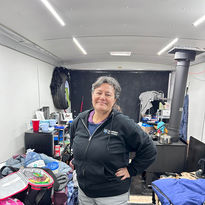
Tibbitt to Contwoyto Winter Road:
Caribou Monitoring Program
The NSMA and caribou
Caribou hold deep cultural significance for the Métis of the North Slave region. For generations, community members have relied on caribou as a staple food source, with the meat also being used to make pemmican—a traditional blend of tallow, dried meat, and berries. Caribou hides have long been crafted into clothing, such as parkas, essential for survival in the northern climate. The caribou has always been central to Métis culture and community life.
However, in recent years there has been a dramatic decline in caribou numbers in the Northwest Territories. The Bathurst herd, named for their traditional calving grounds in Bathurst Inlet Nunavut, has suffered a decline of almost 98% from 470,000 animals in the 1980’s to 6,240 animals in 2021 and their range has contracted significantly. . In 2018, barren-ground caribou were listed as threatened by the NWT Conference of Management Authorities (CMA) (NWT Conference of Management Authorities, 2018). This means that barren- ground caribou is likely to become an endangered species if nothing is done to reverse the factors leading to its extirpation or extinction. The unprecedented decline of this culturally vital herd has spurred NSMA members to take action. In response, the Guardianship Winter Road Monitoring program was established, reflecting NSMA members' commitment to safeguarding their traditional territory.


About Our Program

NSMA’s Guardianship program was developed in 2020 and included caribou monitoring on the Tibbitt to Contwoyto Winter Road. Members would carry out vehicle transects and count caribou and other wildlife along the road. Members would track GPS locations of any wildlife seen along the road and note information such as; health of the animal, sex, approximate age and groups size as well as environmental conditions and human activity.
In Winter 2024, we began construction of a semi-permanent camp on the ice road so that Guardians can stay and monitor caribou for multiple days at a time.
Goals and objectives
Between 2024-2026, NSMA’s goal is to further develop and expand our winter road monitoring program, thanks to funding secured from Government of the Northwest Territories- Cumulative Impact Program. We aim to quantify spatial and temporal relationships between caribou occurrence and mortality (e.g., gut piles) with caribou disturbance factors (vehicles, predators, noise disturbance) along the length of the Tibbitt to Contwoyto winter road throughout the winter road season (Feb-Mar annually).
New data collected in the field (Guardian observations, audio recorders, wildlife cameras) will be compared with member’s traditional and local knowledge. In workshops with members, we will validate field data, note where changes in caribou occurrence and disturbance/mortality factors are suspected from historical conditions, and examine how caribou-people relationships have changed with the road.

Establish a consistent schedule of guardians monitoring the winter road each year with help from our newly hired Winter Road Coordinator.

Traditional Knowledge Input: Provide more local and traditional knowledge of barren-ground caribou to decision-makers and become an active contributor to caribou conservation through traditional knowledge documentation.

Western Science Practices: Develop NSMA's data analysis procedures for wildlife observations, photos, and audio data through a partnership with the State of University of New York College of Environmental Science and Forestry (SUNY-ESF).
Build capacity within the NSMA to play an active role in the study of cumulative impacts and the management of barren-ground caribou by strengthening our existing guardianship program.
Methods
The development and expansion of the Guardianship-led caribou monitoring program has been greatly influenced by the input and guidance of NSMA members. We believe that using both Traditional Knowledge and western science is vital to conservation efforts and thus our program uses both ways of knowing to investigate and protect caribou. We use a combination of approaches including:
1. Community consultation and input through workshops, presentations and training



2. Guardian-led caribou patrols to record caribou numbers, body condition, health, winter habitat and disrespectful harvesting

3. Remote sensory equipment (cameras and ARUS) to investigate disturbances to caribou


































